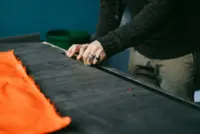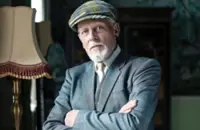Cindy Crawford in Los Angeles on June 5, 2024. Three decades ago she invented the modern playbook by which the current generation of professionally beautiful people flourish. Photo: The New York Times
When Cindy Crawford walked into a lounge in the Santa Monica Proper Hotel on a morning in early June, her vibe was immediate: comfortable, professional, direct.
No artifice. No entourage. Just her longtime publicist Annett Wolf, who made a brief introduction and disappeared, leaving Crawford at the head of a table set with a display of the products from her Meaningful Beauty line of skin and hair care, a US$400mil (approximately RM1.8bil) brand she introduced 20 years ago.
“Where do you want to start?” Crawford asked. “What feels the most organic?”
It’s tempting to describe Crawford, 58, as casual, but that’s not quite it. Dressed in a Celine corduroy jean jacket, a camisole, Nili Lotan bootleg jeans and a Foundrae charm necklace symbolising resilience, her beauty is radiant without being the least bit overwhelming.
A resident of Malibu, where she lives with her husband of 27 years, nightlife and tequila maestro Rande Gerber, she exuded California unfussiness. She is a familiar face, literally, having been photographed and filmed thousands of times over the course of her 35-plus-year career as one of the world’s most successful models.
What felt most organic was to start with the "business of Cindy".
More than the mole above her lip, more than her brown eyes and va-va-voom brown hair and her healthy physique, Crawford’s interest in transcending modelling to become a brand – decades before personal branding was a career path – is what has distinguished her from her peers.
“I always say, ‘I modelled,’” Crawford said. “It’s not, ‘I am a model.’ It’s a verb to me. It’s not an identity.”
An entrepreneurial role model among aspiring supermodels, Crawford invented the modern playbook by which the current generation of professionally beautiful people – including Gigi and Bella Hadid; Hailey Bieber; Crawford’s own daughter, Kaia Gerber; and most of the Kardashian-Jenner family – abide.
Read more: Naomi, Christy, Linda, Cindy! Fashion's supermodels return to tell their stories
Brand partnerships, brand ownership, products, campaigns, deals across various forms of media – all centred on the self.
“There wasn’t someone that I was, like, ‘I want her career,’” Crawford said. “A lot of it was just, like, ‘Why not?’ or ‘Let’s try this.’”
“Cindy, Inc. Not Just Your Basic $7-Million-a-Year Supermodel”: That was the cover line of a 1994 Vanity Fair profile that tried to put a finger on Crawford’s newfangled golden touch as a model who could command markets, demographics and products that ranged from Vogue to Playboy to MTV to Kay Jewelers.
At the time, Crawford was 28, married to Richard Gere (they filed for divorce the next year) and a perfect specimen of youth and exceptional beauty.
Two of the profile’s themes were Crawford’s happiness and the question of whether she would find the “engine” to power her ambitions.
Much was made of her obvious physical appeal, but the article also addressed the fact that Crawford possessed something else – a pragmatism, a lack of pretension and snobbery, a sense of humor and self-awareness – that positioned her for greatness.
“She was born knowing what she was doing,” fashion designer Isaac Mizrahi, one of Crawford’s contemporaries, said in a recent interview. “This is her 15th life or something.”
Thirty years later, Crawford turned out to be the driver of her own career, a rare example of longevity, graceful aging and business savvy in a superficial world famous for discarding women once a whiff of middle age enters the picture.
Crawford has been the face of many brands, perhaps most famously Pepsi. Her blockbuster 1992 Super Bowl ad is advertising legend.
She has been with Omega watches for 29 years. She had a 15-year mega-contract with Revlon that ended when she was 35, at which point she started developing Meaningful Beauty.
It is Crawford’s biggest business, the first ownership stake of her career, a 50-50 partnership with Guthy-Renker, the direct-to-consumer subscription marketing firm known for brands such as Proactiv, JLo Beauty, IT Cosmetics and Tony Robbins Personal Power.
Crawford has never clung to the rarefied world of fashion. In a career unmarked by scandal, one of her most controversial moves was doing Playboy in 1988, tastefully shot by high-fashion photographer Herb Ritts.
Preternaturally savvy at age 22, Crawford has said she thought the Playboy shoot would increase her audience – heterosexual men, as opposed to the primarily female fans of luxury fashion. The wide lens through which she viewed the opportunity has applied to many of her business decisions.
“My most important collaborations were with Pepsi and Revlon, not Hermes,” Crawford said. “They were with brands that are for everybody.”
Raised in a working-class family in DeKalb, Illinois, Crawford has never lost touch with her roots, even at the height of the 1990s glamourama, when she was starring in George Michael’s Freedom! ’90 video and part of Gianni Versace’s inner circle.
“You find yourself at some palazzo in Capri, and you’re, like, ‘Wait, I’m just from DeKalb, Illinois,’” Crawford said. “‘How did I end up here, and what am I supposed to wear?’”
Early in her career, her mother visited her in New York and borrowed one of Crawford’s dresses, a simple style by Donna Karan.
“She’s, like: ‘Oh my god, I love this dress. I’m going to buy one just like it,’” Crawford said.
But it was about US$800 (RM3,800), she remembered, more than what her mother would spend on clothes in a year. Crawford gave her the dress.
“My mom recognised quality when she had it,” Crawford said. “It was an ‘aha’ moment that was about access and knowledge.”
Mizrahi recalled a shoot he did with Crawford in Big Sur, in California, in the 90s.
“The crew and everybody, they just assumed that she was not smart,” Mizrahi said. “I knew her extremely well, and I was, like: ‘What are they talking about? Wait until she opens her mouth.’”
“Then it was, like, they interviewed her for this commercial, and they got clips and sound bites and all that,” he continued.
“And everybody was so amazed that she could speak so eloquently and so incredibly clearly and beautifully. We don’t expect beautiful people to say smart things. That’s awful. That’s a terrible thing to say. But it used to be very true.”
Crawford always had beauty and brains.
In the late 1980s, before the words “super” and “model” were merged to form a new noun to identify the band of models that included Crawford, Christy Turlington, Naomi Campbell, Linda Evangelista and a handful of others, Crawford was known as the small-town Midwestern girl who was co-valedictorian of her high school class and attended Northwestern University on scholarship before dropping out to pursue modelling.
She was fearless, willing to branch out, break the fourth wall and be heard and not just seen – anathema to the modelling world.
Read more: League of extraordinary fashion models? The allure of supermodels lives on
As the inaugural host of MTV’s House Of Style, the beloved behind-the scenes fashion news program that aired in 1989, Crawford had zero broadcast experience. She was no Elsa Klensch, but she made it look easier than it was.
Turlington recalled that when Crawford walked away from House Of Style, Evangelista auditioned to host.
“Linda came in like: ‘I’m a high-fashion model. I’ll really show you what it’s like,’” she said. “It didn’t have the sense of humour, and it didn’t have the lightness.”
Last year, Crawford, Turlington, Evangelista and Campbell were all on camera together for the first time in years for the Apple TV+ series The Super Models.
It was a four-episode trip down memory lane through the headiest of supermodel times – the ups, the downs, the underestimation, the ageing. Campbell and Crawford were the instigators behind getting the foursome together for the series, which was in the works for eight years.
“There is so much obsession with the 90s,” Crawford said. “We’re, like: ‘Someone is going to do this documentary. Let’s own our own narrative.’”
All four women received executive producer credits. None had final cut.
Crawford was mostly happy with the finished product. Her first present-day on-screen moment captures her on a plane, jockeying for a photo that will fetch the highest bid at a charity auction.
“I think we all came off as exactly who we are,” she said. – The New York Times






